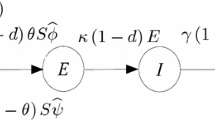Abstract
For epidemic models, it is shown that fatal infectious diseases cannot drive the host population into extinction if the incidence function is upper density-dependent. This finding holds even if a latency period is included and the time from infection to disease-induced death has an arbitrary length distribution. However, if the incidence function is also lower density-dependent, very infectious diseases can lead to a drastic decline of the host population. Further, the final population size after an epidemic outbreak can possibly be substantially affected by the infection-age distribution of the initial infectives if the life expectations of infected individuals are an unbounded function of infection age (time since infection). This is the case for lognormal distributions, which fit data from infection experiments involving tiger salamander larvae and ranavirus better than gamma distributions and Weibull distributions.







Similar content being viewed by others
References
Allen LJS (2003) An introduction to stochastic processes with applications to biology. Pearson Education Inc, Upper Saddle River
Brunner JL, Schock DM, Collins JP (2007) Transmission dynamics of the amphibian ranavirus Ambystoma tigrinum virus. Dis Aquat Org 77:87–95
Burnham KP, Anderson DR (2002) Model selection and multimodel inference: a practical information-theoretic approach, 2nd edn. Springer, New York
Diekmann O (1978) Thresholds and traveling waves for the geographical spread of infection. J Math Biol 6:109–130
Diekmann O, Heesterbeek H, Britton T (2013) Mathematical tools for understanding infectious disease dynamics. Princeton University Press, Princeton
Diekmann O, de Koeijer AA, Metz JAJ (1996) On the final size of epidemics within herds. Can Appl Math Quart 4:21–30
Docherty DE, Meteyer CU, Wang J, Mao J, Case ST, Chinchar VG (2003) Diagnostic and molecular evaluation of three iridovirus-associated salamander mortality events. J Wildl Dis 39:556–566
Farrell AP (2017) Prey-predator-parasite: an ecosystem model with fragile persistence. Dissertation, Arizona State University
Farrell AP, Collins JP, Greer AL, Thieme HR (preprint) Do fatal infectious diseases eradicate host species?
Grauert H, Lieb I (1967) Differential - und Integralrechnung. Springer, Heidelberg
Gray MJ, Chinchar VG (eds) (2015) Ranaviruses: lethal pathogens of ectothermic vertebrates. Springer, Cham
Green DE, Converse KA, Schrader AK (2002) Epizootiology of sixty-four amphibian morbidity and mortality events in the USA, 1996–2001. Ann NY Acad Sci 969:323–339
Greer AL, Briggs CJ, Collins JP (2008) Testing a key assumption of host-pathogen theory: density and disease transmission. Oikos 117:1667–1673
Hassett MJ, Stewart DG (1999) Probability for risk management. ACTEX Publications, Winsted
Heesterbeek JAP, Metz JAJ (1993) The saturating contact rate in marriage and epidemic models. J Math Biol 31:529–539
Kermack WO, McKendrick AG (1927) A contribution to the mathematical theory of epidemics. Proc R Soc A 115:700–721 (reprinted: Bull Math Biol 53(1991):33–55)
Martcheva M (2015) An introduction to mathematical epidemiology. Springer, New York
Rass L, Radcliffe J (2003) Spatial deterministic epidemics. AMS, Providence
Sartwell PE (1950) The distribution of incubation periods of infectious diseases. Am J Hyg 51:310–318
Sartwell PE (1966) The incubation period and the dynamics of infectious disease. Am J Epid 83:204–318
Thieme HR (1977) A model for the spatial spread of an epidemic. J Math Biol 4:337–351
Thieme HR (2003) Mathematical population biology. Princeton University Press, Princeton
Acknowledgements
The authors thank Andrea Pugliese and two anonymous referees for careful reading and useful comments.
Author information
Authors and Affiliations
Corresponding author
Additional information
Dedicated to Odo Diekmann on the occasion of his 70th birthday.
Rights and permissions
About this article
Cite this article
Farrell, A.P., Collins, J.P., Greer, A.L. et al. Times from Infection to Disease-Induced Death and their Influence on Final Population Sizes After Epidemic Outbreaks. Bull Math Biol 80, 1937–1961 (2018). https://doi.org/10.1007/s11538-018-0446-y
Received:
Accepted:
Published:
Issue Date:
DOI: https://doi.org/10.1007/s11538-018-0446-y




